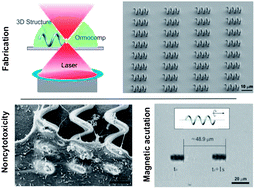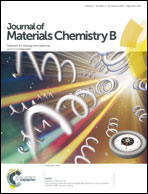Noncytotoxic artificial bacterial flagella fabricated from biocompatible ORMOCOMP and iron coating†
Abstract
Magnetic microrobots have potential use in biomedical applications such as minimally invasive surgery, targeted diagnosis and therapy. Inspired by nature, artificial bacterial flagella (ABFs) are a form of microrobot powered by magnetic helical propulsion. For the promise of ABFs to be realized, issues of biocompatibility must be addressed and the materials used in their fabrication should be carefully considered. In this work, we fabricate the helical bodies of ABFs from a commercially available biocompatible photoresist, ORMOCOMP, by subsequently coating them with Fe for magnetic actuation. 3-(4,5-Dimethylthiazol-2-yl)-2,5-diphenyltetrazolium bromide (MTT) assays show that Fe-coated ORMOCOMP layers do not undermine the cell viability during 72 hours of incubation compared to control substrates. Cells exhibit normal morphology on ABF arrays and show good lamellipodial and filopodial interactions with the ABF surfaces. The swimming performance of Fe-coated ABFs is characterized using a three-pair Helmholtz coil arrangement. ABFs exhibit a maximum forward speed of 48.9 μm s−1 under a field of 9 mT at a frequency of 72 Hz. In summary, our Fe-coated ABFs exhibit little cytotoxicity and have potential for in vivo applications, especially those involving difficult to access regions within the human body.

- This article is part of the themed collection: 2014 Journal of Materials Chemistry B Hot Articles

 Please wait while we load your content...
Please wait while we load your content...